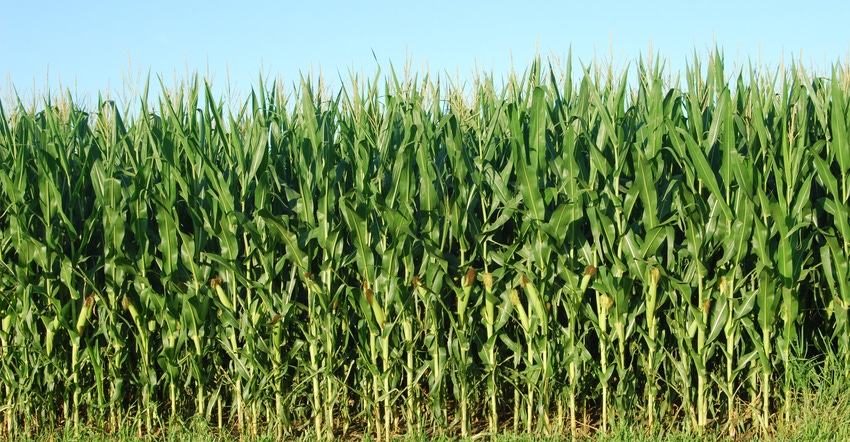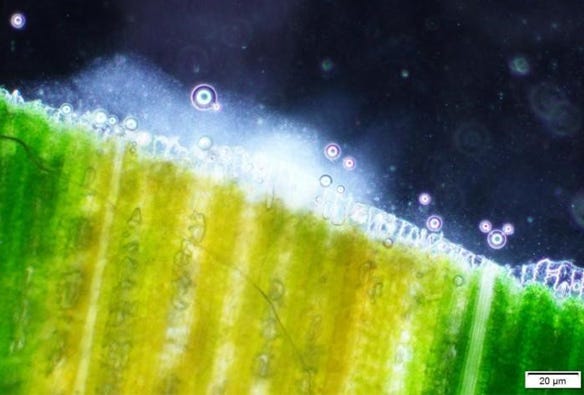August 3, 2018

By Ethan Stoetzer and Edward Zaworski
Iowa State University Extension plant pathologists have identified and confirmed several different cases of bacterial leaf streak in corn this growing season. Bacterial leaf streak is relatively new to the U.S., with the first case identified in 2016, though symptoms of the disease have been present in Nebraska since 2014.
To date, the disease has been reported in nine states: Colorado, Illinois, Iowa, Kansas, Minnesota, Nebraska, Oklahoma, South Dakota and Texas. This video offers information on testing and sampling for bacterial leaf streak.
Scouting and identifying
Because the disease isn’t widely recognized and can often be misdiagnosed in fields, it’s important to understand how to properly scout for and identify it.
Bacterial leaf streak is caused by the bacterium Xanthomonas vasicola, and has been observed on field corn, seed corn, popcorn and sweet corn. Symptoms begin as narrow leaf lesions with wavy edges that occur between the veins of corn leaves and can range between one to several inches long. Lesions may be yellow, tan, brown or orange, and look greasy or water-soaked.
 SYMPTOMS: Yellow, tan and brown lesions form in bands across the leaf blade. Holding the sample up to the light will sometimes illuminate these bands to aid in diagnosis.
SYMPTOMS: Yellow, tan and brown lesions form in bands across the leaf blade. Holding the sample up to the light will sometimes illuminate these bands to aid in diagnosis.

These lesions can occur anywhere on the leaf blade, sometimes close to the midrib, and can appear translucent with bright-yellow halos, which when backlit, are easy to see extending from the lesions. Over time, the lesions can expand to cover larger areas of the leaf. In extreme cases, the lesions may extend along the entire length of the leaf, and grow together to form large, necrotic areas.
Not much is known about the disease cycle of bacterial leaf streak, due to the recency of the identification in the U.S. Researchers presume the bacterium overwinters in infected crop residue because the disease has been observed on volunteer corn present in a soybean field, where the disease had been identified the previous year in corn.
It is assumed that irrigation, splashing rain and wind-driven rain spread the bacterium, but it is unknown how far the bacterium can travel. It’s also assumed that a plant needs to be wounded for infection to occur.
Disease symptoms have been observed in corn as early as the V7 growth stage, in which lesions first appear on lower leaves. However, because of the disease's recent arrival to the Midwest, not much data has been collected on the earliest appearances of the pathogen for scouting windows. Under favorable conditions — continuous corn production, overhead irrigation or rainfall during hot weather — the disease spreads up the plant canopy, though symptoms could also appear only in the upper canopy.
Symptoms in the upper canopy are more common when the disease occurs after tasseling. Some reports indicate bacterial leaf streak appears after high wind and rain events. Under these favorable conditions, disease severity can approach 30%.
Similar diseases can be confusing
Scouting for bacterial leaf streak can be difficult, as its symptoms can be mistaken for other common diseases — grey leaf spot and common rust. A lab can easily distinguish bacterial leaf streak from fungal diseases through bacterial streaming.

BACTERIAL STREAMING: When water is applied to an infected tissue sample and viewed under a microscope, bacteria will stream out of the sample and into the water.

Bacterial streaming is an identification process that entails placing a small section cut from the edge of a leaf lesion in a droplet of water on a microscope slide. Under a microscope, you can observe the bacterial cells streaming out from the cut edge of the lesion. However, other bacterial diseases also produce this streaming, so you should confirm the presence of the bacterium by sending a sample to the Iowa State University Plant and Insect Diagnostic Clinic.
Management recommendations
Little information is available when it comes to managing bacterial leaf streak. Field observations suggest corn hybrids differ in susceptibility. Once hybrids can be screened for resistance, planting resistant hybrids will be the best way for farmers to manage bacterial leaf streak. Like other bacterial diseases, such as Goss’s wilt, there are no effective chemical controls.
Researchers do not recommend tillage to reduce the risk of bacterial leaf streak, due to the need to manage soil erosion. While bacterial leaf streak has been most commonly observed in overhead-irrigated fields, it is also known to occur under both flood irrigation and dryland conditions.
Likewise, researchers only have limited information about bacterial leaf streak’s impact on yield. Researchers anticipate losses to be minimal if symptoms develop late in the growing season, or if extensive leaf blight does not occur before or during grain fill.
Stoetzer is communications specialist with ISU’s Integrated Pest Management Program; Zaworski is plant diagnostician at ISU’s Plant and Insect Diagnostic Clinic.
You May Also Like




